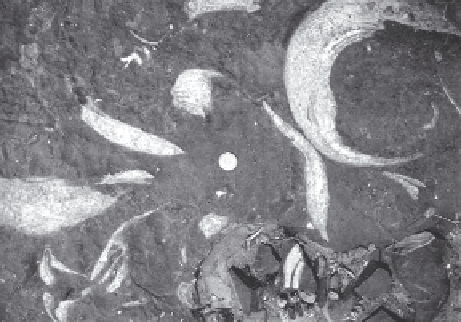Geology Reference
In-Depth Information
1988; Scheibner and Reijmer 1999; Monaco 2000). The
bivalves preferred different subenvironments and lived
in intertidal and subtidal low energy, marginal marine
as well as in high energy shelf-margin settings com-
prising the standard facies zones 4, 5, 7 and 8. Shell
concentrations were controlled by physical and biologi-
cal agents such as shell transport by currents and waves,
winnowing fine-grained material leaving behind shell
coquinas, bioturbation resulting in shell concentration,
and in-situ growth contributing to the formation of low-
diversity bivalve reefs near platform margins and on
upper slopes (Fig. 10.41).
Fig. 10.41.
Lithiotis
limestone contributing to the formation
of mounds near a platform-upper slope margin. The dark fine-
grained sediment corresponds to bioclastic pack- and wacke-
stones. Early Jurassic: Jebel Bou Dahar, High Atlas Moun-
tains, Morocco. Coin for scale. From Scheibner and Reijmer
(1999).
Middle and Late Jurassic limestones with
'fila-
ments':
The name refers to fossils first recognized in
thin sections of Jurassic limestones and later also in
rock-building quantities in other Mesozoic open-ma-
rine limestones, e.g. the Late Triassic Hallstatt lime-
Plate 88 Cretaceous Rudist Bivalves
Rudists are sessile gregarious bivalves characterized by a lower attached and an upper opercular valve of differ-
ent sizes. The group appeared in the Late Jurassic and disappeared at the end of the Cretaceous. Rudists were
common throughout the Cretaceous. Diversity dropped during the Early Aptian and the latest Cenomanian and
increased significantly in the Early Maastrichtian.
Major subgroups are differentiated by shell morphology, the number and position of teeth, accessory cavities,
canals (-> 2), pores and pillars. Thin sections exhibit characteristic microstructural patterns. The shells consist
of an inner and middle aragonitic layer (nearly always recrystallized and replaced by blocky calcite, ->5) and an
outer Low-Mg calcite layer with compact (-> 1, 6) and/or cellular microstructures (-> 1, 4, 5).
Caprinidae
(-> 2;
Aptian to Maastrichtian, common in Cenomanian) are characterized by characteristic canals within the shell.
The shells of
Radiolitidae
(-> 1, 4, 5, 6; Late Aptian to Maastrichtian, common from the Late Albian onwards,
abundant from Santonian to Maastrichtian) exhibit a reticulate pattern caused by the calcitic cellular prismatic
outer layer, and a compact inner layer. Both groups were abundant in outer and mid-shelf environments. The
Hippuritidae
(-> 3; Turonian to Maastrichtian), forming densely packed biostromes, are characterized by pillars
within the shell wall.
1
Radiolitidae.
Lower valves of
Lapeirausia
sp. Oblique cross-section. Note pseudopillars (P) and thick outer layers show-
ing the diagnostic alternation of the thick cellular boxwork ostracum and thinner compact microstructures. The interspaces
between the shells are infilled with silt-sized prismatic calcite crystals (CC) resulting from the disintegration and spalling
of parts of the shells. Radiolitids are common in outer to mid-shelf environments. SMF 8. Late Cretaceous (Campanian):
Greece.
2
Caprinidae.
Upper valve of
Sphaerocaprina
sp. Transverse section. Note the inner shell layer exhibiting a system of
morphologically differentiated polygonal and pyriform canals (C). The interior cavities of the shell are filled with bio-
clasts, coated grains and rounded intraclasts. Caprinids are common in outer to mid-shelf deposits. Late Cretaceous
(Cenomanian): Northern Greece.
3
Hippuritidae.
Transverse section of the cylindrical lower valve of
Hippurites colliciatus
Woodward. Hippuritid rudists
are characterized by a thick outer compact calcite layer (CL), a thin inner aragonite layer (AL) and two pillars (P) project-
ing towards the general cavity. Late Cretaceous (Early Campanian): Pontides, northern Turkey.
4
Radiolitidae
. Radial section. Note the folded cellular network made of horizontal laminae and vertical elements. Late
Cretaceous: Lake Belton, Texas, U.S.A.
5
Radiolitidae.
Sauvagesia
sp. The primarily aragonitic inner layer is replaced by blocky calcite. The thick, finely cellular
calcitic outer layer consists of prismatic cells. Late Cretaceous (Cenomanian): Greece.
6
Radiolitidae.
The outer layer of the upper valve consists of compact calcite. Note the degradation of the shell by boring
(arrow). These Cretaceous rudist limestones in the Italian and Slovenian part of the Trieste area are famous decorative
building stones. Late Cretaceous (Santonian): Duino near Trieste, Italy.
-> 1-3, 5: Courtesy of T. Steuber (Bochum)

